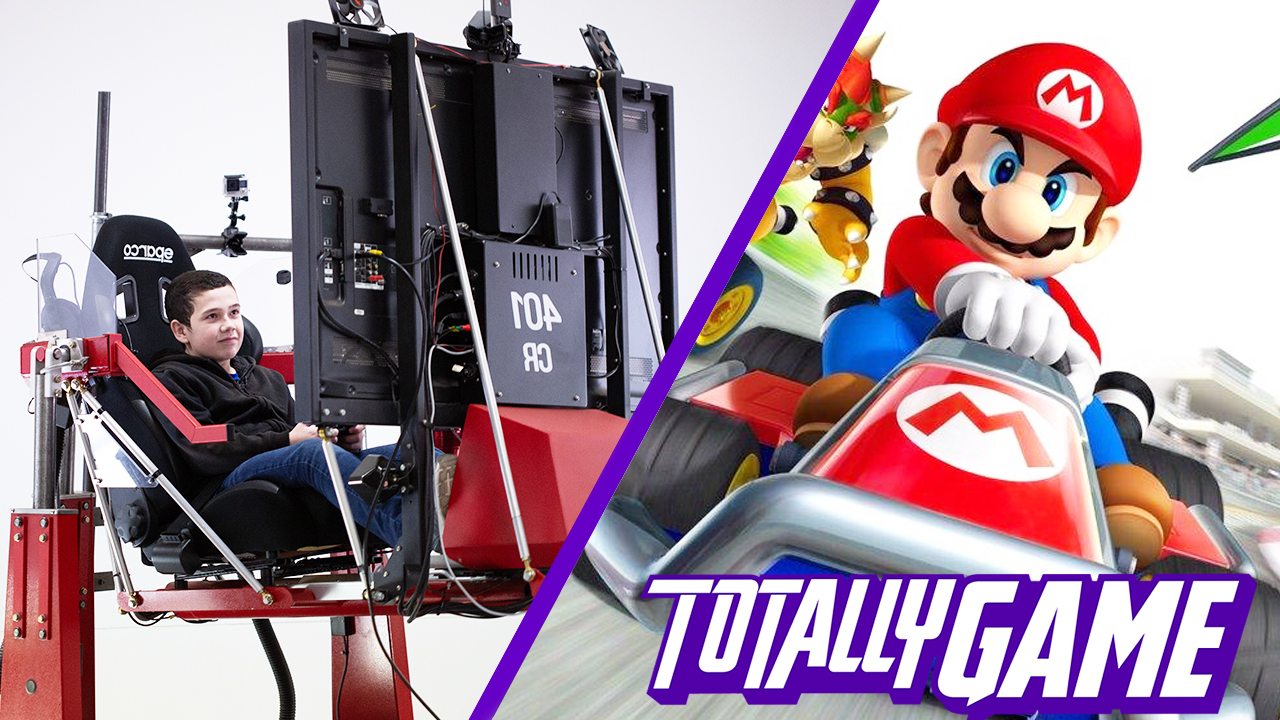

Many fans of the BigN are currently eagerly awaiting the Nintendo Switch Pro console, which will allow games like Mario Kart to be played at higher frame rates and resolutions than on the Nintendo Switch and Nintendo Switch Lite – and maybe even at a 4K resolution.
Mario Kart Live: Home Circuit, meanwhile, has brought Mario Kart into the age of augmented reality, with the add-on allowing gamers to race around their own homes while playing the racing game thanks to neat AR tech.
However, one engineer has just put the Nintendo Switch Pro and Mario Kart Live: Home Circuit firmly into the shade, and taken playing Mario Kart to to a whole new level of immersion and awesomeness.
That's because David Wiernicki, of Trumansburg, NY, owns Force Dynamics, a company that makes high-end motion simulators. And the father and business owner has created a way to hook up Home Circuit to his impressive simulators, which are often used to train race drivers, resulting in the ultimate Mario Kart experience.
Check it out in the below video:
“This is the best possible version of Mario Kart," states David. "Gaming is something that transports you somewhere else, that makes you believe you're doing something else you couldn't be doing otherwise.
“What I build is a way to make that even more real. When I'm sitting in the machine, I’m doing that as someone who grew up playing games and wanted more and better, and this is how I'm delivering that ‘better’ to myself.”
Get all the latest news, reviews, deals and buying guides on gorgeous tech, home and active products from the T3 experts
Nintendo’s latest entry in the Mario Kart series brings the iconic racer into the real world, with physical “karts” that can be raced around any real-world space, such as players’ living rooms.
The game uses physical “gates” which players set up however they want, then uses those gates as reference points to create a virtual map of the real-world circuit.
The karts then race through the gates while kart-mounted cameras send video to the Nintendo Switch, allowing players to race around their own real-world tracks on their TV.
David explained how he got the idea to take things a step further: “My son, Draco, is 12 years old and he got the Switch a few months ago for his birthday.
“Mario Kart Live came out and we said ‘there’s something we can do with this’. And that was the genesis of this whole thing.”
David then conceived of an ingenious setup which involves using accelerometers mounted to the physical karts, which send data to a PC mounted to the simulator, which in turn drives the motion of the simulator.
David said: “Initially, my developer, Dave, and I got a regular radio-controlled car and hooked an accelerometer and a really crappy camera onto it, just as an experiment to see if it worked.
“And lo and behold, it worked. It was actually really fun to drive over an extension cord and feel like you're driving over a log.”
One of the challenges of this system is that, due to the small size of the karts, the signals sent by the accelerometer need to be adjusted in order for the simulators not to enact massive, exaggerated movements.
David continued: “Those little Mario karts only weigh a few ounces. They can accelerate really fast. So what we're doing is we're scaling up the motion of one of those to real-car size.
“If you imagine scaling up one of those things and then driving it over bumps, it's not going to be comfortable. You're going to be shaking all over the place.
“The lightness of those karts and the lack of real suspension means that when you translate this little thing up to a big thing, what you're feeling is pretty intense.
“The challenge is to get enough of that across where you say ‘we're experiencing what this kart is really experiencing’ while making it something that’s usable.”
Luckily David and his team were able to modify their in-house software to ensure no-one gets whiplash playing Home Circuit on one of his simulators.
To complete the experience, the video from the Kart-mounted camera is sent to the Nintendo Switch and screen onboard the simulator, resulting in an immersive, one-of-a-kind experience.
It’s the kind of thing gamers grow up dreaming about, and luckily for Draco, his dad had the resources to bring the experience to life.
Founded in 2005, Force Dynamics specialises in building simulators that go beyond the kind of racing simulators found in arcades.
David said: “You go to an arcade and you can sit in a little thing and drive around, which is not that fun. But you can do a high-end version of that where you're really feeling everything that’s going on. And that's what you can use our simulators for.”
Aside from being used for gaming, David’s simulators have been used by researchers looking into autonomous cars and by car manufacturers who want to give consumers the experience of driving high-end vehicles at trade shows.
But being able to play Mario Kart Live: Home Circuit with his son has been a highlight for David, who says watching his son play makes everything worth it.
“I'm really happy to be able to do stuff like this with Draco. To be able to be in a position where I can build something like this, which is authentically cool to young people is great.
“It’s one of the best things about this, about Mario Kart, about the business, about everything I'm doing is that Draco is getting to to see this and to experience things that most kids don’t.”
- These are the best Nintendo Switch games to play today

Rob has been writing about computing, gaming, mobile, home entertainment technology, toys (specifically Lego and board games), smart home and more for over 15 years. As the editor of PC Gamer, and former Deputy Editor for T3.com, you can find Rob's work in magazines, bookazines and online, as well as on podcasts and videos, too. Outside of his work Rob is passionate about motorbikes, skiing/snowboarding and team sports, with football and cricket his two favourites.